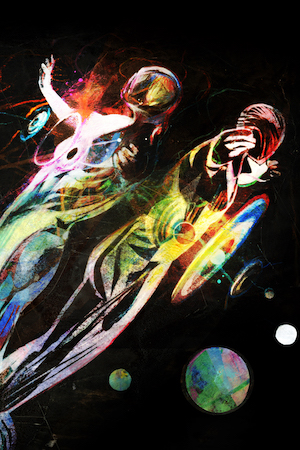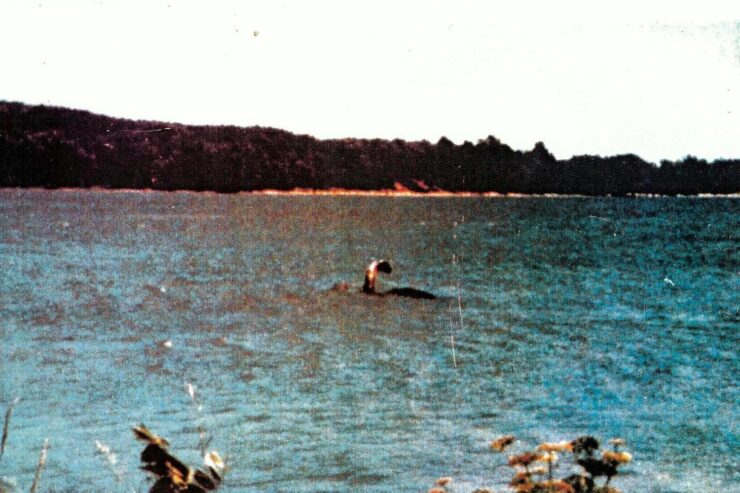Thanks to commenter Raskos, I’ve picked up a copy of Peter Costello’s book, In Search of Lake Monsters, and I’m working my way through it. Meanwhile, let’s watch some TV. I’m the mood this week for some Jess and Phil, so Expedition X it is. Sure enough, at the end of Season 2, they headed for Lake Champlain to investigate its famous monster.
The episode opens with a piece of photographic evidence. In 1977, Sandra Mansi photographed a strange beast on Lake Champlain. The photo looks quite a bit like the famous photo of the Loch Ness Monster, which has been conclusively debunked: a long neck and a dinosaur-like head. But unlike the Nessie photo, we’re told, it’s been analyzed and declared not to be a forgery. The University of Arizona is mentioned, which is a nice little coincidence—that’s my local major educational institution.
Host Josh Gates shows Phil and Jess the photo. Jess of course is thrilled; she’s the believer on the team. Phil the field biologist reserves judgment, but allows as how he can’t totally exclude the possibility that there’s something in the lake. He suggests it may be a Lazarus species, a surviving example of a species believed to be extinct.
Josh spends a little time on the history of giant unknown beasts sighted in the lake from the 1700s onward. The Abenaki, he says, told tales of a great serpent called Gitaskog that lives in the lake.
In 1819, a certain Captain Crum claims to have seen “a monstrous beast raising its massive head out of the water.” Later in the century, a railroad crew claims to have seen “a mysterious sea creature… an absolute monster with silvery scales.” And most impressive of all, over a hundred passengers and crew on the steamship W.B. Eddy ran into the giant whatever-it-was and nearly capsized.
These stories tell of a silvery, scaled, serpentine creature, twenty to thirty feet long. The Mansi photo shows something like a dinosaur. That one doesn’t look like any fish I know of. It’s something else.
So what is it? That’s always the question. Josh speculates that it may be a species of ancient whale, a plesiosaur, “or even some other unidentified creature of massive proportions.”
Sightings have continued since 1977, and Phil and Jess are sent to talk to recent witnesses. They begin with a professional fisherman who not only saw something in the evening at the end of a bass tournament, but videoed it. The video shows a long, dark line on the surface of the water. It was at least as long, the witness says, as his twenty-foot boat.
The video is typical of cryptid evidence. It’s blurry, pixelated, and hard to make out. The witness declares that he was able to circle it, and “it started to show itself in between the waves.” While he was still recording, it disappeared under the water. He’s never seen anything like it in all his years of fishing.
The place where he saw the thing is in a part of the lake that’s about 350 feet deep. Lake Champlain is a big lake; it was briefly included in the Great Lakes, which kind of makes it the Pluto of that group of very large lakes. It’s 120 miles long and up to 400 feet deep, with over ninety species of fish. Plenty of room there for a creature of massive size.
Phil and Jess debate whether this could be a Lazarus species, possibly a plesiosaur. They cite the icon of the genre, the coelacanth, which was thought to be extinct for millions of years. If there is something like that in there, they hope to catch sight of it during a night investigation, since Champ, as the beast is affectionately known, seems to be nocturnal.
Something big bumps into the boat, but they aren’t able to identify or record it. In hopes of more success, they get in touch with author Katy Elizabeth, whose “Champ Search” has been hunting for the creature, at that point, for eight years. She claims to have seen Champ in 2012, or an object that she believes to be Champ. Twelve to fifteen feet long, she says, and black or blackish brown. To her it seems to be some kind of large snake.
She believes that this is an ancient species, “either reptile or amphibian, or perhaps a hybrid of both.” She points out that the lake freezes over in winter, so the creature has to be able to breathe somehow. Maybe it’s like the native snapping turtle, able to breathe through, basically, its butt.
Phil doesn’t buy this, but Elizabeth is sure that Champ is not only amphibious, it comes on shore. It’s not completely aquatic. She’s seen frequent reports of tracks in the marsh, she says, and signs of something dragging in the mud. She believes Champ is an opportunistic feeder, eating whatever it can find, including snakes, frogs, and even “snatching seagulls off the surface of the water.”
Moreover, in 2019, she captured an image by sonar that she believes is Champ, resting on the bottom of the lake. She saw what she says is a “horse-like head with […] hornlike protuberances on top,” and a long neck. She’s also taken photos of long dark wavelike things on the surface of the like, similar to what the fisherman recorded.
Phil has started to think, well, maybe Champ is an amphibian after all, and that’s how it survives and why it’s been so hard to capture. The night investigation of the marsh yields results like the one on the lake: indications of something big just outside of camera range, and drag marks of something huge in the mud. Phil says the marks remind him of sea turtle tracks, but they’re a long way from the sea.
He really wants to find a scientific explanation. To that end, he and Jess visit a science and nature museum in the area, and speak to an expert on Champ and on the local ecosystem. She shows them the original Mansi photo.
That, Jess notes, could be a creature on its side, and the curved thing rising up out of the water could be a flipper. Which I can see, too, if I shift my perspective. Or, Phil suggests, it might be a fish jumping out of the water. The expert thinks it could be the wake of a boat.
Most witnesses, she says, describe something between ten and forty feet long. The latter is pretty unlikely, but there is one species of fish that falls into the lower edge of the range. That’s the sturgeon, which can get up to eight feet long and lives for up to a hundred years. They’re bottom feeders, which means they’re rarely seen, but once in a great while they come up to the surface.
There’s another possibility: a smallish whale. It would have come into the lake about ten thousand years ago, when it was open to the ocean, and it might have evolved to survive in fresh water. The same might be true of plesiosaurs, who seem to have been able to live in brackish waters.
That brings us back to the Lazarus theory, and the idea that there might be a prehistoric reptile in the lake. Josh observes that this is similar to the lore of Loch Ness, another very deep lake which was once connected to the ocean.
That’s Phil’s signal that its time for a dive. He’ll go down deep and try to find places where a large animal or fish might hide. This being Expedition X, he has cool tools to help him along, including a camera that can film as far down as 650 feet. Jess remote-controls that while Phil investigates in person.
It’s a rich ecology. Plenty of food for an aquatic or amphibious predator. And plenty of places for that predator to hide.
He sees something huge and fast down there, but neither he nor the camera manages to capture it. All he sees is a massive cloud of silt, and the suggestion of something big.
At this point we get an intermission. Josh shows us the iconic photo of Nessie, and tells us how in 1994 the person who publicized the photo confessed to faking it. It was a model of a dinosaur’s head and neck, attached to a toy submarine. A hoax, in short—unlike, says Josh, the supposedly authenticated Mansi photo.
I would point out that a photo of a dinosaur model on a submarine could be authenticated insofar as analysis would indicate that’s it’s not doctored or photoshopped. It’s a fake monster but a real photo. So I’m not convinced it’s for real. Nor, I notice, are other and more expert observers.
Meanwhile, back at the lake, the camera finds a shipwreck. Excitement! The big whatever it was led them straight to it! Maybe, says Jess, that’s where it hides. Phil agrees: fish like to lair in wrecked ships. It’s a good place for a predator to lurk in search of prey.
Something grabs the camera and and swirls it around in a cloud of silt. So dramatic. Of course, this being a possible cryptid, it disappears before they can catch an image of it.
The upshot is that, as usual, they don’t find anything. None of Phil’s colleagues can identify the drag marks in the marsh. His best guess about his dive is that he spooked a gigantic sturgeon.
Jess maintains that it might be a sea creature marooned in the lake after it separated from the ocean. Whale, plesiosaur. Something unknown to science, living in the depths and occasionally rising to the surface.
It seems there really is something big down there, whatever it is. It’s certainly captured the imagination of people who live near the lake, and fed the tourist industry, complete with street art and adorable plushies. There’s even legal protection: in 1986, the Vermont legislature followed New York in “passing a resolution that says the creature, if one exists, should be spared harm”.
I’m on team sturgeon, with a side bet on a floating log or an odd wave. But then again, a lake as big and deep as Champlain just might be hiding a cryptid, and keeping it well fed, too.










